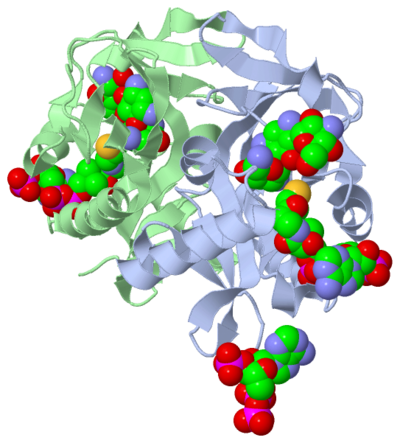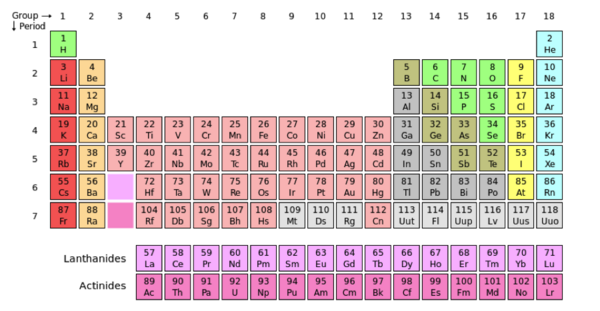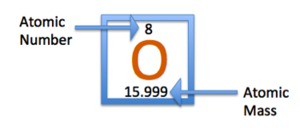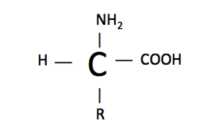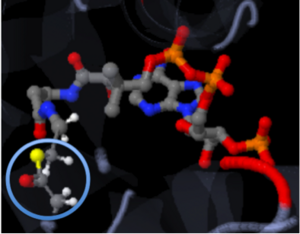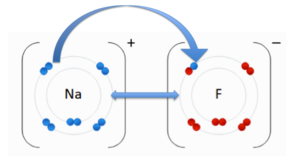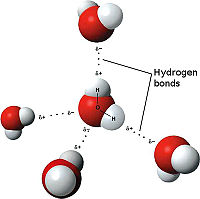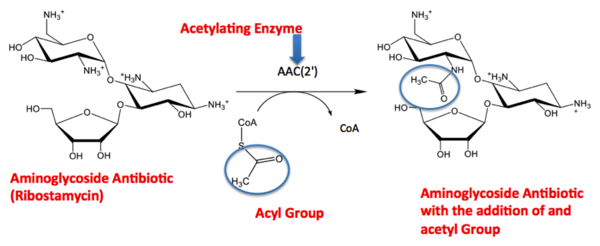Objectives
By the end of this tutorial you should be able to:
1. Describe and provide examples of covalent bonds, ionic bonds, and hydrogen bonds
2. Describe Primary Structure
3. Understand and identify the importance of secondary structures
4. Understand and describe an active site
4. Describe what a ligand does. Competitive/Allosteric inhibitors and inducers
7. Be able to classify amino acids and understand what the classification represents
Periodic table
An atom is the smallest unit of matter. Protons, neutron, and electrons, make up the composition of an atom providing its physical features. The common physical features of atoms are used to organize them in the periodic table. Electrons are negatively charged particles that surround the atom’s nucleolus. Protons are positively charged particles and neutrons are uncharged. Both neutrons and protons are located in the central part of the atom known as the nucleus.
The image to the left displays Oxygen (O) in its periodic box. The atomic mass of oxygen is 8, centered above the single-letter abbreviation of Oxygen. “8” represents the number of protons in the atom’s nucleolus. The atomic number is also used to arrange elements in the periodic table, notice the increasing value of protons in the atoms from left to right. The atomic mass of an element is centered under the single-letter abbreviation of the atom and represents the total weight of the atom, in this case oxygen has an atomic mass of ~16. The total weight of an atom is the sum of the atoms protons, neutrons and electrons.
The periodic table is a collaboration of atoms that are arranged according to their common features. Groups are the vertical columns of atoms, and the periods are the horizontal columns. When moving from left to right across the periods (horizontally), there is an increase in electronegativity. Electronegativity refers to the atoms ability to pull other electrons towards it, increasing its density and providing it’s self with a negative charge. The concept of electronegativity contributes to the polarity of a molecule.
Polarity is caused by a difference in electronegativity between atoms in a compound and/or the asymmetry of the compounds structure. A compound is nonpolar when the electronegativity of the atoms/functional groups are close or even. The compound is symmetrical and the electrons are not being pulled more in one direction.
Amino acids
Amino acids are the building blocks of proteins. There are about 500 amino acids but we will be referencing the 20 more common ones. Polymer chains (peptides) join amino acids together to form proteins. The process of protein formation is known as translation. During translation, a complex known as the ribosome is responsible for adding amino acids to a peptide chain to form a complete protein.
20 More Common Animo Acids
- Alanine (ala)(A)
- Glycine (gly)(G)
- Isoleucine (ile)(I)
- Leucine (leu)(L)
- Methionine (met) (M)
- Phenylalanine (phe)(F)
- Proline (pro)(P)
- Valine (val) (V)
- Arginine (arg)(R)
- Asparagine (asn)
- Aspartic acid (asp)(D)
- Cysteine (cys)
- Glutamic Acid (glu)(E)
- Glutamine (gln) (Q)
- Histidine (his)(H)
- Lysine (lys) (K)
- Serine (ser) (S)
- Threonine (thr)(T)
- Tryptophan (trp) (W)
- Tyrosine (tyr)(Y)
The basic structure of an amino acid is an amine group (-NH2), a carboxylic acid (-COOH), hydrogen (H), and a functional group (R). The functional group is what varies between amino acids. The functional group determines how the amino acid is categorized. They are categorized as essential/nonessential, polar/non-polar, and acidic/basic.
Classification of Amino Acids
Essential vs. Nonessentail Amino Aicds
An amino acid is considered essential when the human body is not capable of synthesizing/producing it. These amino acids need to be obtained from our diet. If the body is capable of producing an amino acid through metabolism or another method, the amino acid is classified as nonessential.
Essential Amino Acids
- Histidine (his)
- Isoleucine (ile)
- Leucine (leu)
- Lysine (lys)
- Methionine (met)
- Phenylalanine (phe)
- Threonine (thr)
- Tryptophan (trp)
- Valine (val)
Nonessential Amino Acids
- Alanine(ala)
- Arginine (arg)
- Asparagine (asn)
- Aspartic acid, (asp)
- Cysteine (cys)
- Glutamic acid (glu)
- Glutamine (gln)
- Proline (pro)
- Serine (ser)
- Tyrosine (tyr)
Neutral, Polar vs. Nonpolar Amino Acids
The polarity of an amino acid is dependent on the difference in electronegativity and the asymmetry of the compounds structure, discussed previously. For example, Arginine is a polar amino acid and Glycine is a nonpolar amino acid. As we learned earlier, an amino acid structure consists of a carboxylic acid, an amine, hydrogen, and a functional group. Look at the structure of arginine; the amine group, carboxylic acid and hydrogen are located towards the bottom of the representation. The functional group is the large extension of atoms upward. You can see from this image that the functional group has a greater density/electronegativity compared to the rest of the structure, hence making this amino acid polar. In contrast the structure of glycine, located next to arginine, has little polarity. The functional group attached is only a methyl group (CH3), which has low density/electronegativity compared to the rest of the structure making glycine a nonpolar amino acid. Neutral amino acids have functional groups that are similar in electronegativity, so the electrons are not pulled in one direction more dominantly then another. In other words, there is no increase in density to one side. When an amino acid is neutral, it is less reactive then a polar amino acid. It is less reactive because the structure is stable. A polar amino acid is pulling electrons yielding a slight positive and negative charge with in the amino acid structure, making it less stable. Those charges want to react with other atoms, yielding the higher reactivity.
Nonpolar amino acids
- Alanine (ala)
- Glycine (gly)
- Isoleucine (ile)
- Leucine (leu)
- Methionine (met)
- Phenylalanine (phe)
- Proline (pro)
- Valine (val)
Polar Amino Acids
- Arginine (arg)
- Asparagine (asn)
- Aspartic acid (asp)
- Cysteine (cyc)
- Glutamic Acid (glu)
- Glutamine (gln)
- Histidine (his)
- Lysine (lys)
- Serine (ser)
- Threonine (thr)
- Tryptophan (trp)
- Tyrosine (tyr)
Neutral Amino Acids
- Alanine (ala)
- Asparagine (asn)
- Cysteine (cyc)
- Glutamine (gln)
- Glycine (gly)
- Isoleucine (ile)
- Leucine (leu)
- Methionine (met)
- Phenylalanine (phe)
- Proline (pro)
- Serine (ser)
- Threonine (thr)
- Tryptophan (trp)
- Tyrosine (tyr)
- Valine (val)
Acidic vs. Basic Amino Acids
An Example of a pH scale is located above. A pH scale is a scale that ranges from 1-14. An acidic pH is a pH below 7. A basic pH is greater then 7. A pH of 7 is considered neutral (ex: water). Some common acidic functional groups are alcohols (OH) and carboxylic acids (COOH). Some examples of basic functional groups are amines (NH3) and ethers (CH2OCH2).
Acidic Amino Acids
- Aspartic acid (asp)
- Glutamic acid (glu)
Basic Amino Acids
- Arginine (arg)
- Histidine (his)
- Lysine (lys)
Types of Bonds
There are three common types of bonds. These bonds include hydrogen bonds, covalent bonds, and ionic bonds. The strongest bond is a covalent bond, followed by the ionic bond, which leaves the weakest bond to be the hydrogen bond. Knowing where these bonds are utilized will aid in your understanding of why a structure is in a certain conformation.
Covalent Bonds
[4]
The strongest type of bond is the covalent bond. Covalent bonds involve the sharing of electrons between two molecules/atoms. These bonds are very stable and are not easily broken. This represents Coenzyme A (CoA) with the addition of an acyl group to the sulfur. The acyl group is bound to CoA through covalent bonds. In the picture below, the acyl group is circled. All of the solid connecting bonds are covalent bonds.
| Element Color Code
|
|
Carbon- Grey
Nitrogen- Blue
Sulfur- Yellow
Oxygen- Red
|
Ionic Bonds
An ionic bond is an attraction between two molecules of opposite charge. The opposite charge is either positive (+) or negative (-). A positively charged atom is referred to as a cation, and a negatively charged atom is referred to as an anion. In the image to the right, you see an anion, Fluorine (F) and the cation, Sodium (Na). These two atoms are attracted to each other due to their opposite charges. The double-sided arrow between them is representation of their attractive force. This representation highlights an ionic interaction between Tobramycin and Aspartic acid (Asp). The nitrogen on Tobramycin has a (+) positive charge and Aspartic acid has a (-) negative charge. The opposing charges are attracted to each other forming an ionic bond.
Hydrogen Bonds
The weakest bond, the hydrogen bond is an attractive interaction between an electronegative atom and hydrogen. Electronegative atoms have high electron density. High electron density refers to strong atoms that pull electrons towards it from weaker/low electron density atoms, such as hydrogen. When the electronegative atom pulls the electrons, it leaves the other atom with a slightly positive charge. A common example of this is water. The image to the right demonstrates the hydrogen bonding in water. The highly electronegative oxygen pulls the hydrogen closer by attracting hydrogen’s electrons. When oxygen pulls the electrons, it leaves hydrogen with a slight positive charge. Since oxygen is pulling the hydrogen’s inward, the formation of a water droplet is possible. In this representation the hydrogen bonds are represented as yellow-dashed lines. The hydrogen bonds are important in this study and this molecular compound because they offer the stability of the secondary structures.
Primary Structure
The primary sequence of a compound is the amino acid linear sequence of the compound. For example the linear sequence of tobramycin is displayed below. The chemical formula is C18H37N5O9. If you count each of the elements the number should match.
Secondary Structures
Secondary structures are alpha helices and beta sheets. The helices and sheets provide stability to the molecule as a whole. The alpha helices are represented with pink arrows and the beta strands are represented with yellow arrows. This molecule has approximately eight alpha helices and four beta sheets. Alpha helices have a cylinder-like structure that rotates in a clockwise manner with a parallel formation. This representation shows these key features of alpha helices. Here, you can see the helices rotating clockwise (follow the arrows), and the parallel formation within the cylinder structure. The parallel alpha helices are held in its cylinder structure by hydrogen bonds. Beta sheets are often anti-parallel, which are clearly represented in this figure. The folding of a protein, alpha helices and beta sheets, is what gives the compound its function. When there is a change in protein folding, the function will change.
Active Site
The active site of a molecule can be described as a pocket where an interaction between compounds occurs. This interaction will cause a change in structure shape. The conformational change, change in structure shape, can inhibit or activate the physiological/pathological affect. The active site can either be inhibited or activated by the compound that binds there. Referring back to our article, the active site is where the acetylation is going to occur. In this depiction of the active site you can see the pocket where Coenzyme A (CoA) will aid the enzyme in the acetylation of Tobramycin (Toy), the aminoglycoside antibiotic. The enzyme is the "blob" surrounding the antibiotic and CoA. The enzyme/protein is holding these compounds in a conformation forcing them to react. The acetylation at the active site will cause the antibiotic to be inactive, hence inhibiting the active site. When Tobramycin becomes inactivated it is no longer able to aid in the destruction of bacteria. This is what we call antibiotic resistance.
Substrates
A substrate is a compound that is acted upon by the enzyme. The substrate binds the active site of the enzyme, once bound the enzyme transfers a functional group(s) to the substrate. After the substrate has collected the functional group(s) it is released from the active site. When this occurs the substrate can go on to bind the enzymes compound of interest and transfer the acquired functional groups to produce the product. Once the final transformation occurs the product is either inhibited or activated by the conformational change.[3]
This equation is a representation of the interaction between a substrate and an enzyme. As you can see the enzyme (E) and substrate (S) start off as two stand alone compounds, but then join together at the enzymes active site to form the enzyme-substrate (ES) compound. Once the enzyme releases the substrate you are left with the final product (P) and the enzyme (E).
From the article summary you know that AAC(2’) has a similar fold to that of the GNAT superfamily. The GNAT fold described in the study has the function of acetylation, the addition of an acetyl group. An acetyl functional group is composed of CH3CO. It is important to note that the discovery of the GNAT fold lead to the understanding of the function of AAC(2’). The reaction centered above is the acetylation that occurs to the aminoglycoside antibiotic causing its inactivity. The Acetylation was reconstructed and modified from the article “Aminoglycoside 2’ –N- Acetyltransferase from Mycobacterium tuberculosis in complex with Coenzyme A and aminoglycoside substrate”, the research article we have been referencing. From the reaction centered above you see the aminoglycoside antibiotic (Ribostamycin) being acted upon by the enzyme AAC(2’). AAC(2’) is adding and acetyl group to the antibiotic using the substrate CoA. On the right side of the arrow you can see the final product of the acetylation, the antibiotic and acyl group bound. The Acetyl group is circled, so you are able to locate it throughout the reaction. Acetylation is one of the more common reactions that occurs.[2]
Ligand
Ligands are molecules or complexes that are located within the secondary structures. The ligands are held in a certain conformation by the secondary structure. This conformation contributes to the function of the compound, as mentioned before. Ligands can have binding sites on receptors. When bound to the receptor it can trigger a physiological response. A ligand can be a competitive agonist, allosteric agonist, competitive antagonist, or an allosteric antagonist. An agonist is a ligand that causes a physiological response, activating the active site. An antagonist is a ligand that inhibits a physiological response, not allowing the active site to be activated.
A ligand is competitive when it is binding to the same site as the physiological activator; hence it is competing for the same site. When a ligand binds to an allosteric site, the ligand is binding to the same receptor but it is not binding to the active site. The ligands present in the research article complex are coenzyme A, Tobramycin and Phosphate-Adenosine-5'-Diphosphate. The ligands in this complex are represented as a dimer. A dimer is a chemical structure formed from two identical subunits. Some molecules are present as a dimer because it is more stable then the monomer, one subunit. The dimer is constructed by connecting two subunits along their axis.
The hide-aways boxes located below provide more information about CoA and Tobramycin for those who are interested.
| Coenzyme A (CoA)
|
| Coenzyme (CoA) is a coenzyme that synthesizes and oxidizes fatty acids. This process is essential for the utilization of fatty acids. Coenzyme A is used as a substrate in the citric acid cycle. The citric acid cycle is also known as the Krebs cycle or tricarboxylic acid cycle (TCA). This process is important to the production of ATP, which is an energy source used by the body.
|
| Tobramycin
|
|
Tobramycin is an antibiotic that is part of the aminoglycoside family. Aminoglycosides produce antibacterial effects by inhibiting protein synthesis and compromising the cell wall structure. By inhibiting the protein synthesis of the bacteria, it does not allow the bacteria to replicate. The cell wall is an important structure to bacteria because it provides the structure and stability to the bacteria. By disrupting the cell wall, we are removing the stability of the bacteria and ultimately casing bacteria death. [7]
Tobramycin targets a variety of bacteria, particularly gram(-) species. Just like all drugs there are side effects associated with tobramycin. Some of the more common side effects are ototoxicity and nephrotoxicity. Ototoxicity is hearing loss and nephrotoxicity is causing kidney damage. The kidney damage is due to Tobramycin reabsorption through the renal tubules. This basically means that tobramycin may be toxic to the kidneys because of prolonged contact time in the kidneys.ref name="Tobramycin">
Tobramycin trade name is Tobrex. A trade name is another name for tobramycin. It is a pregnancy category D. Pregnancy categories are assigned to all drugs. They are used to classify how likely the drug is to cause harm to the fetus. The pregnancy categories are A, B, C, D, and X. Pregnancy category A causes no harm to the fetus and pregnancy category X indefinitely causes harm to the fetus. Since Tobramycin is a pregnancy category D, this is not an optimal choice for a pregnant patient.ref name="Tobramycin">
Tobramycin can be given intravenously, intramuscularly, as an inhalation or ophthalmicly. Intravenously is an IV route of administration where the drug is administered directly to the vasculature or blood vessels. Intramuscular is a shot that penetrates your muscle. A common example of an intramuscular administration would be the flu shot. Inhalation is a route of administration where the lungs are the targets. An example of this would be an inhaler used in asthmatics. Ophthalmic administration is where the drug is administered to the eye; an example would be an eye drop.ref name="Tobramycin">
|
http://www.elmhurst.edu/~chm/vchembook/561aminostructure.html
